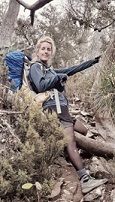Doctor Lina Teckentrup
 I am an environmental modeler with an interest in vegetation dynamics and the associated carbon cycle response. I completed my Master’s degree in Meteorology at the University of Hamburg; however my initial excitement for atmospheric physics and clouds was soon surpassed by my interest in interactions between the atmosphere and the land surface. For my master’s thesis based at the Max Planck Institute for Meteorology, I analysed sensitivity experiments from the FireMIP project to understand which processes drive uncertainty in simulated burned area. In 2019, I moved to Sydney to do my PhD at the Climate Change Research Centre at the University of New South Wales. My thesis focussed on uncertainties linked to carbon cycle simulations and aimed to derive a constrained estimate of the Australian terrestrial carbon cycle using the dynamic global vegetation model LPJ-GUESS.
I am an environmental modeler with an interest in vegetation dynamics and the associated carbon cycle response. I completed my Master’s degree in Meteorology at the University of Hamburg; however my initial excitement for atmospheric physics and clouds was soon surpassed by my interest in interactions between the atmosphere and the land surface. For my master’s thesis based at the Max Planck Institute for Meteorology, I analysed sensitivity experiments from the FireMIP project to understand which processes drive uncertainty in simulated burned area. In 2019, I moved to Sydney to do my PhD at the Climate Change Research Centre at the University of New South Wales. My thesis focussed on uncertainties linked to carbon cycle simulations and aimed to derive a constrained estimate of the Australian terrestrial carbon cycle using the dynamic global vegetation model LPJ-GUESS.
At HIE, I work with Professor Matthias Boer on projects applying machine-learning frameworks to the prediction of fuel types under future climates, and fire risk. I am also involved in Professor Belinda Medlyn’s Laureate project which aims to develop a Dynamic Vegetation Model for Australia. My broad research interests include vegetation dynamics in semiarid and arid ecosystems and their responses to ongoing climate change, the contribution of terrestrial vegetation to the global carbon cycle on interannual to multidecadal timescales, and developing both statistical and dynamic models of fire dynamics.
Bushfire Research
Our research also includes the role of fire and its effects on global change. Please see here (opens in a new window) for further details on our bushfire research.
Awards and Recognition
- Excellence in Research Impact, Deputy Vice-Chancellor and Vice-President (Research, Enterprise and International) Research Award, with HIE Bushfire Research Group, Western Sydney University, 2023.
Publications
Beringer J, Moore CE, Cleverly J, Campbell DI, Cleigh H, De Kauwe MG, Kirschbaum MUF, Griebel A, Grover S, Huete A, Hutley LB, Laubach J, Van Niel T, Arndt SK, Bennett AC, Cernusak LA, Eamus D, Ewenz CM, Goodrich JP, Jiang M, Hinko-Najera N, Isaac P, Hobeichi S, Knauer J, Koerber GR, Liddell M, Ma X, Macfarlane C, McHugh ID, Medlyn BE, Meyer WS, Norton AJ, Owens J, Pitman A, Pendall E, Prober SM, Ray RL, Restrepo-Coupe N, Rifai SW, Rowlings D, Schipper L, Silberstein RP, Teckentrup L, Thompson SE, Ukkola AM, Wall A, Wang Y-P, Wardlaw TJ, Woodgate W, (2022) 'Bridge to the future: Important lessons from 20 years of ecosystem observations made by the OzFlux network', Global Change Biology, vol.28, no.11, pp 3489 - 3514
Teckentrup L, De Kauwe MG, Pitman AJ, Goll DS, Haverd V, Jain AK, Joetzjer E, Kato E, Lienert S, Lombardozzi D, McGuire PC, Melton JR, Nabel JEMS, Pongratz J, Sitch S, Walker AP, Zaehle S, (2021) 'Assessing the representation of the Australian carbon cycle in global vegetation models', Biogeosciences, vol.18, pp 5639-5668
Teckentrup L, De Kauwe MG, Pitman AJ, Smith B, (2021) 'Examining the sensitivity of the terrestrial carbon cycle to the expression of El Nino', Biogeosciences, vol.18, pp 2181-2203
Hantson S, Kelley DI, Arneth A, Harrison SP, Archibald S, Bachelet D, Forrest M, Hickler T, Lasslop G, Li F, Mangeon S, Melton JR, Nieradzik L, Rabin SS, Prentice IC, Sheehan T, Sitch S, Teckentrup L, Voulgarakis A, Yue C, (2020) 'Quantitative assessment of fire and vegetation properties in simulations with fire-enabled vegetation models from the Fire Model Intercomparison Project', Geoscientific Model
Development, vol.13, pp 3299-3318
Melton JR, Arora VK, Wisernig-Cojoc E, Seiler C, Fortier M, Chan E, Teckentrup L, (2020) 'CLASSIC v1.0: the open-source community successor to the Canadian Land Surface Scheme (CLASS) and the Canadian Terrestrial Ecosystem Model (CTEM) – Part 1: Model framework and site-level performance', Geoscientific Model Development, vol.13, pp 2825-2850
Teckentrup L, Harrison SP, Hantson S, Heil A, Melton JR, Forrest M, Li F, Yue C, Arneth A, Hickler T, Sitch S, Lasslop G, (2019) 'Response of simulated burned area to historical changes in environmental and anthropogenic factors: a comparison of seven fire models', Biogeosciences, vol.16, pp 3883-3910